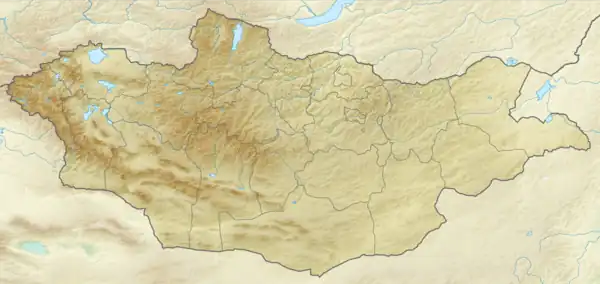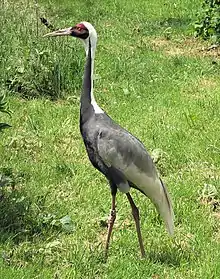Mongol Daguur Biosphere Reserve
Mongol Daguur Biosphere Reserve is a nature reserve in the Dornod Aimag (Province) in eastern Mongolia, preserved as an example of one of the largest areas of intact grassland in the world. It covers 8,429,072 hectares (20,828,690 acres) and was designated as a UNESCO Biosphere Reserve in 2005.[1] Together with Ugtam Nature refuge and Daursky Nature Reserve in Russia it constitutes a World Heritage Site named "The Landscapes of Dauria".[2]
| Mongol Daguur Biosphere Reserve | |
|---|---|
 | |
| Coordinates | 49°50′N 115°4′E |
| Area | 8,429,072 ha (20,828,690 acres) |
| Type | Natural |
| Criteria | ix, x |
| Designated | 2017 (41st session) |
| Reference no. | 1448 |
History
Mongol Daguur was declared a biosphere reserve by UNESCO in 2005.[1] A biosphere reserve aims to preserve the environment while allowing local communities to be involved in sustainable development.[3] The core area of a biosphere reserve is strictly protected, the buffer zone is used for research and similar activities, and the transition zone allows the local communities to undertake ecologically sustainable activities.[4]
Description

Mongol Daguur has a total area of 8,429,072 hectares (20,828,690 acres) and is located between 46°06' to 46°52'N and 116°11' to 118°27'E. Its altitudinal range is between 700 and 1,100 m (2,300 and 3,600 ft) above sea level. It consists of a core area of about 570,374 hectares (1,409,420 acres) surrounded by a buffer zone of 1,072,220 hectares (2,649,500 acres) and a transition area of 6,786,477 hectares (16,769,750 acres). Habitats present include temperate steppe, rocky outcrops, sand dunes and marshes.[1]
The reserve is divided into two areas. The larger, northern area lies alongside a protected area in Russia, the Daursky Nature Reserve. It lies to the south of Lake Barun-Torey and consists of grass steppes and some wetlands. The smaller, southern area consists of the Ulz River basin and associated wetlands. This area is home to the rare white-naped crane (Grus vipio) and other species of crane.[5] The core zone is designated as a Special Protected area and is managed for the conservation of the herds of Mongolian gazelle (Procapra gutturosa). The transition areas are used for sustainable tourism, and for grazing livestock, the culling of wildlife as necessary, forest maintenance, and the gathering of medicinal plants for household use by the pastoral population of about 11,800 residents.[1]
References
- "Mongol Daguur". Biosphere Reserve Information: Mongolia. UNESCO. 10 December 2007. Retrieved 18 November 2015.
- "Landscapes of Dauria".
- "World Network of Biosphere Reserves". Ecological Sciences for Sustainable Development. UNESCO. Retrieved 18 November 2015.
- "MAB leaflet 2015" (PDF). UNESCO. Retrieved 18 November 2015.
- Blunden, Jane (2014). Mongolia. Bradt Travel Guides. p. 148. ISBN 978-1-84162-416-7.
External links
- Landscapes of Dauria UNESCO Collection on Google Arts and Culture